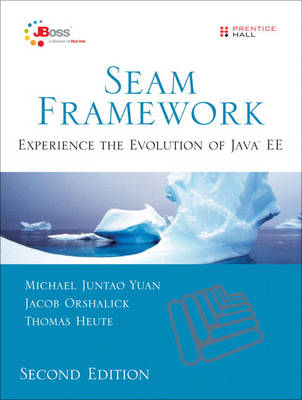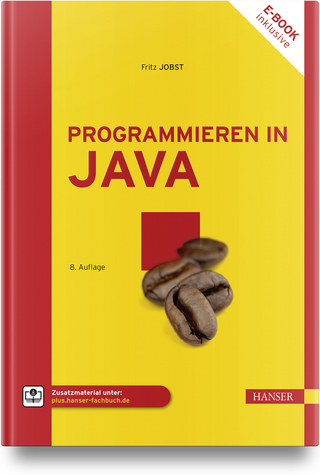
Seam Framework
Prentice Hall (Verlag)
978-0-13-712939-3 (ISBN)
- Titel ist leider vergriffen;
keine Neuauflage - Artikel merken
In Seam Framework, Second Edition, the authors of the leading guide to Seam programming have systematically updated their text to reflect the major improvements introduced with Seam 2.x. This author team–all key Seam project contributors–teach Seam 2.x through detailed example applications that reveal how Seam simplifies many tasks that were previously difficult or impractical. Their robust descriptions are complemented by in-depth feature discussions that demonstrate how to use Seam’s power to the fullest. Whether you’re new to Seam programming or a seasoned Seam developer who wants to achieve deeper mastery of Seam 2.x, this book will be an indispensable resource.
Coverage includes
Using improvements to Seam’s conversation model, transaction management, and other features
Enhancing security, performing end-to-end validation, and providing custom exception pages
Using Quartz to execute timer jobs in your application
Generating bookmarkable RESTful Web pages the easy way
Developing highly scalable applications with Seam 2.x’s new multilayer caching
Simplifying development with Groovy, the scripting language that runs directly on the JVM
Using jBPM business processes to improve page flow
Previewing Web Beans (JSR-299), the future core of Seam that will transform Java EE Web development
*Download source code for this book’s case study application at solutionsfit.com/seam.
Michael Juntao Yuan is cofounder of Ringful, LLC, a company that develops RESTful APIs for telephone voice and mobile messaging solutions. He contributes code to the Seam project and writes about Seam at www.michaelyuan.com/blog. Formerly technical product manager at Red Hat’s JBoss division, Yuan is author of five books on software development. Jacob Orshalick is an independent consultant and the owner of Focus IT Solutions, LLC. He has developed enterprise software solutions that span the retail, financial, media, and telecommunications industries. He specializes in developing enterprise Java solutions utilizing open source technologies and agile techniques. He is a committer to the Seam project, and you can find Jacob writing about Seam, Web Beans, and related Java EE technologies in his blog, www.solutionsfit.com/blog. Thomas Heute was a contributor to the pre-JBoss Portal project before being hired by JBoss, Inc., in 2004. He started as a member of the JBoss Portal team but became a JBoss Seam coleader in 2005, with a plan to bring EJB3 closer to JSF (where it really should be). At the end of 2006, Thomas returned to the JBoss Portal team to work on a range of tasks.
About This Book xvii
About the Authors xix
Acknowledgments xxi
Part I: Getting Started 1
Chapter 1: What Is Seam? 3
1.1: Integrating and Enhancing Java EE Frameworks 4
1.2: A Web Framework That Understands ORM 5
1.3: Supporting Stateful Web Applications 6
1.4: Web 2.0 Ready 7
1.5: POJO Services via Dependency Bijection 7
1.6: Convention over Configuration 8
1.7: Avoiding XML Abuse 8
1.8: Designed for Testing 9
1.9: Great Tools Support 10
1.10: Let’s Start Coding! 10
Chapter 2: Seam Hello World 11
2.1: Create a Data Model 13
2.2: Map the Data Model to a Web Form 13
2.3: Handle Web Events 14
2.4: Navigate to the Next Page 15
2.5: EJB3 Bean Interface and Mandatory Method 16
2.6: More on the Seam Programming Model 17
2.7: Configuration and Packaging 20
2.8: How Is This Simple? 25
Chapter 3: Recommended JSF Enhancements 27
3.1: An Introduction to Facelets 28
3.2: Seam JSF Enhancements 34
3.3: Add Facelets and Seam UI Support 38
3.4: PDF, Email, and Rich Text 40
3.5: Internationalization 46
Chapter 4: Seam without EJB3 47
4.1: A Seam POJO Example 47
4.2: Configuration 48
4.3: Packaging 50
4.4: POJO Trade-Offs 52
Chapter 5: Rapid Application Development Tools 53
5.1: Prerequisites 54
5.2: A Quick Tutorial 54
5.3: Working with IDEs 63
5.4: Generating a CRUD Application from a Database 72
5.5: Seam-gen Command Reference 73
Part II: Stateful Applications Made Easy 75
Chapter 6: An Introduction to Stateful Framework 77
6.1: Correct Usage of ORM 77
6.2: Better Performance 79
6.3: Better Browser Navigation Support 81
6.4: Fewer Memory Leaks 82
6.5: High Granularity Component Lifecycle 83
6.6: Reducing Boilerplate Code 84
Chapter 7: Thinking in Components 87
7.1: Stateful Components 87
7.2: Managing Stateful Components 92
7.3: Configuring Components through XML 97
7.4: Page Navigation Flow 99
Chapter 8: Conversations 101
8.1: What Is a Conversation? 102
8.2: Long-Running Conversations 106
8.3: Managing Long-Running Conversations 112
8.4: New Frontiers 124
Chapter 9: Workspaces and Concurrent Conversations 125
9.1: What Is a Workspace? 125
9.2: Workspace Management 129
9.3: Natural Conversations 134
9.4: Workspace Timeout 140
9.5: Desktop Features in a Stateless Web 143
Chapter 10: Nested Conversations 145
10.1: Why Are Nested Conversations Needed? 145
10.2: Continuing the Conversation 147
10.3: The Conversation Stack 152
10.4: Fine-Grained State Management 157
Chapter 11: Transactions and Persistence 159
11.1: Seam-Managed Transactions 160
11.2: Atomic Conversation (Web Transaction) 165
Part III: Integrating Web and Data Components 175
Chapter 12: Validating Input Data 177
12.1: Form Validation Basics 177
12.2: Validation Annotations on Entity Beans 179
12.3: Triggering the Validation Action 181
12.4: Displaying Error Messages on the Web Form 183
12.5: Using JSF Custom Validators 185
Chapter 13: Clickable Data Tables 187
13.1: Implementing a Clickable Data Table 188
13.2: Seam Data-Binding Framework 191
Chapter 14: Decoupling Components Using Events 193
14.1: The Observer Pattern 193
14.2: Component-Driven Events 196
Chapter 15: Bookmarkable Web Pages 203
15.1: Using Page Parameters 204
15.2: The Java-Centric Approach 207
15.3: RESTful Web Services 211
Chapter 16: The Seam CRUD Application Framework 213
16.1: Data Access Objects (DAOs) 213
16.2: Seam CRUD DAOs Are POJOs 214
16.3: A Declarative Seam DAO Component 215
16.4: Queries 218
Chapter 17: Failing Gracefully 223
17.1: Why Not Standard Servlet Error Pages? 223
17.2: Setting Up the Exception Filter 225
17.3: Annotating Exceptions 225
17.4: Using pages.xml for System Exceptions 227
17.5: The Debug Information Page 229
Chapter 18: Seam Security 233
18.1: Authentication and User Roles 234
18.2: Declarative Access Control 237
18.3: Identity Management 243
18.4: Additional Security Features 251
Part IV: AJAX Support 257
Chapter 19: Custom and AJAX UI Components 259
19.1: Autocompletion Text Input Example 261
19.2: Rich Input Control Examples 263
19.3: A Scrollable Data Table 264
19.4: Using RichFaces with Seam 265
19.5: Other JSF Component Libraries 266
Chapter 20: Enabling AJAX for Existing Components 269
20.1: AJAX Validator Example 270
20.2: Programmatic AJAX 272
20.3: AJAX Buttons 274
20.4: AJAX Containers 276
20.5: Other Goodies 276
20.6: Using Ajax4jsf with Seam 277
20.7: Pros and Cons 278
Chapter 21: Direct JavaScript Integration 279
21.1: AJAX Validator Example (Reloaded) 280
21.2: AJAX Progress Bar 284
21.3: Integrating the Dojo Toolkit 287
Part V: Business Processes and Rules 293
Chapter 22: Rule-Based Security Framework 295
22.1: Rule-Based Access Control 295
22.2: Configuring Rule-Based Permissioning 296
22.3: Simple Access Rules 297
22.4: Per-Instance Access Rules 299
22.5: Securing Your Entities 302
Chapter 23: Integrating Business Rules in Web Applications 305
23.1: Embedded Rules 305
23.2: Generic Rules 309
23.3: Building and Deployment 312
23.4: Conclusions 313
Chapter 24: Managing Business Processes 315
24.1: jBPM Concepts and Vocabulary 316
24.2: Application Users and jBPM Actors 318
24.3: Creating a Business Process 320
24.4: Managing Tasks 325
24.5: Business Process-Based Page Navigation Flow 330
24.6: jBPM Libraries and Configuration 333
Chapter 25: Integrating Business Processes and Rules 335
25.1: The Process 335
25.2: The Rules 337
25.3: Conclusions 338
Part VI: Testing Seam Applications 339
Chapter 26: Unit Testing 341
26.1: A Simple TestNG Test Case 343
26.2: Simulating Dependency Bijection 344
26.3: Mocking the Database and Transaction 345
26.4: Loading the Test Infrastructure 347
Chapter 27: Integration Testing 351
27.1: Simulating JSF Interactions 352
27.2: Using JSF EL Expressions 353
27.3: Transactional Data Source 355
Part VII: Production Deployment 357
Chapter 28: Using a Production Database 359
28.1: Installing and Setting Up the Database 359
28.2: Installing the Database Driver 361
28.3: Defining a Data Source 361
28.4: Configuring the Persistence Engine 362
28.5: How about Tomcat? 362
Chapter 29: Java EE 5.0 Deployment 365
29.1: JBoss AS 4.0.5 365
29.2: JBoss AS 4.2.x and 5.x 366
29.3: GlassFish 367
Chapter 30: Performance Tuning and Clustering 371
30.1: Tuning Performance on a Single Server 372
30.2: Clustering for Scalability and Failover 379
Part VIII: Emerging Technologies 383
Chapter 31: Scheduling Recurring Jobs from a Web Application 385
31.1: Simple Recurring Events 386
31.2: Configuring the Quartz Scheduler Service 387
31.3: Scheduling Cron Jobs 389
31.4: Scheduling Jobs When Starting Up 390
31.5: Conclusion 391
Chapter 32: Improving Scalability with Multilayered Caching 393
32.1: Multilayered Caching 394
32.2: Integrating a Cache Provider through Seam 396
32.3: Simplified Caching with Seam 398
Chapter 33: Making Seam Groovy 401
33.1: Groovy Entities 402
33.2: Groovy Actions 405
33.3: Integrating Groovy 406
Chapter 34: Introduction to Web Beans 409
34.1: Defining a Web Beans Component 410
34.2: Component Injection 411
34.3: Producer Methods 414
34.4: The Context Model 416
34.5: Component Stereotyping 419
34.6: Implementing Cross-Cutting Behavior 421
34.7: Conclusion 423
Appendix A: Installing and Deploying JBoss AS 425
A.1: JDK 5.0 Is Required 425
A.2: Installing JBoss AS 426
A.3: Deploying and Running Applications 426
Appendix B: Using Example Applications as Templates 427
B.1: Simple EJB3-Based Web Applications 428
B.2: POJO-Based Web Applications 433
B.3: More Complex Applications 438
Appendix C: Using Maven 441
Appendix D: Direct Access to the Hibernate API 451
D.1: Using the Hibernate API 451
D.2: Configuration 453
Index 455
| Erscheint lt. Verlag | 13.3.2009 |
|---|---|
| Zusatzinfo | Illustrations |
| Verlagsort | Upper Saddle River |
| Sprache | englisch |
| Maße | 234 x 178 mm |
| Gewicht | 794 g |
| Themenwelt | Informatik ► Programmiersprachen / -werkzeuge ► Java |
| Mathematik / Informatik ► Informatik ► Web / Internet | |
| ISBN-10 | 0-13-712939-4 / 0137129394 |
| ISBN-13 | 978-0-13-712939-3 / 9780137129393 |
| Zustand | Neuware |
| Informationen gemäß Produktsicherheitsverordnung (GPSR) | |
| Haben Sie eine Frage zum Produkt? |
aus dem Bereich


